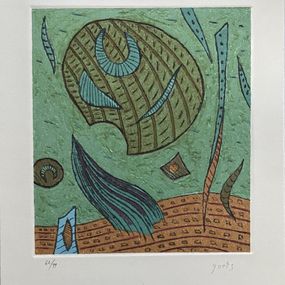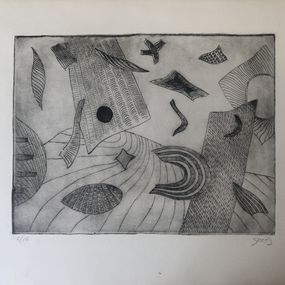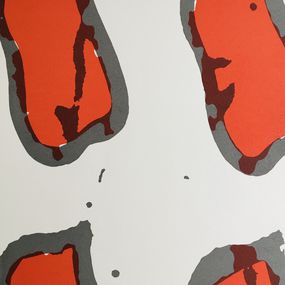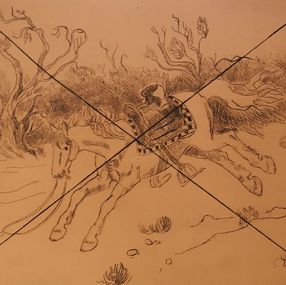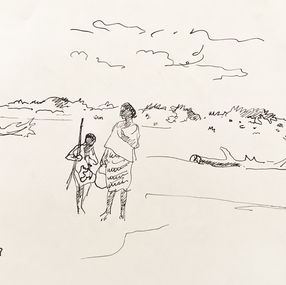
Sans titre I,
1980
Henri Goetz
Print : aquatint, etching
26 x 19 cm 10.2 x 7.5 inch
Free returns within 14 days
Authenticity guaranteed
Learn moreSecure payment
About the artwork
Type
Numbered and limited to 30 copies
Signature
Signed artwork
Authenticity
Sold with certificate of Authenticity from the gallery
Invoice from the gallery
Dimensions cm • inch
26 x 19 cm 10.2 x 7.5 inch Height x Width x Depth
Support
Framing
Not framed
Tags
Artwork sold in perfect condition
Artwork location: France
Etching : 13.5 x 17 cm
Paper : 19 x 26 cm
Excellent condition.
Collector’s Guide
Imagine it at home

Discover more by the artist
Presentation
The origins
Henri Goetz's family is of French origin. Around 1850, his grandfather, Bernard Goetz, an Alsatian from the Colmar region, left France for the United States. A handyman, during his long journey he invented a sort of reflector to better illuminate his reading, his main pastime, in a dimly lit cabin. This simple invention aroused the admiration of his traveling companions and he quickly received the offer of a first-class traveler to exploit this discovery upon their arrival in Philadelphia.
In 1855, Bernard Goetz opened a reflector company, The American Reflector Company, which later became The B. Goetz Manufacturing Company. He married an American woman with whom he had five children. At the age of eleven, the youngest child Henri's father was expelled from school, unable to learn spelling and therefore unfit to pursue more advanced studies. An apprentice mechanic in the new bicycle industry, he took part in cycling races. An onset of tuberculosis prevented him from pursuing his cycling career, but he began writing short stories during the years spent in the American West. Back in the East, he married the woman who would be the mother of Henri Goetz.
Childhood
Henri Goetz was born in 1909 in New York, where his father ran an electrical equipment company. An only child, he received a strict education from his mother, for whom educational principles replaced affection. In 1916, his family left New York to settle in the suburbs of Far Rockaway, Queens. Goetz completed primary and secondary school there, and then high school.
His dream of leaving home came true in 1927 when he went to study in Boston, at the Massachusetts Institute of Technology, with a view to preparing for a career as an electrical engineer. It was at this time that he began to be interested in art and took drawing lessons. In 1929 he enrolled at Harvard University, where he took courses in art history. He left university the same year to take painting classes at the Grand Central School of Art in New York.
One day, a painting student tells him about her personal experience of Paris and its workshops. This is enough to trigger in Goetz the desire to leave for France.
The years of learning
Arriving in Paris in 1930, he worked in the academies of Montparnasse (Académie Julian and Académie de la Grande Chaumière) and for some time in the studio of the painter Amédée Ozenfant. Goetz is interested in portraiture and the study of the nude. His goal is to express the character of his models through an exterior and interior resemblance using an expressionist and very colorful style. He ardently mixes the cubist process and expressionist color.
“At the beginning, I devoted myself solely to portraiture, because the human figure seemed to me to contain a warmth that I had not found in my studies where I was preparing for a career as an electrical engineer During these six years, the painting learned in the academies served me to create resemblances and to deepen the intimacy of the gaze of others. »
Goetz found himself immersed in the artistic world of Montparnasse. Until then, his knowledge of painting did not go beyond impressionism. His friend, the painter Victor Bauer, opened his mind to living painting. “I owe him the triggering of the second stage of my evolution," says Goetz.
He discovered the works of Pablo Picasso, Georges Braque, Henri Matisse, Georges Rouault, Paul Klee and Vassily Kandinsky. Through Bauer, Goetz also became familiar with Freudianism, left-wing politics, primitive sculpture, poetry and avant-garde music. He then continued the study of portraiture and began to paint in 1933 his first landscapes of simplistic and laborious construction, in a violent, dark and very impasto material, where the combined influence of Fauvism and Cubism are found. His self-portrait from 1935 is constructed with shapes strongly marked by Cubism, but in a lively and pure color, borrowed from Fauvism. From 1932 to 1934, Goetz lived at 16 rue Bardinet in Paris.
In 1935, Goetz considered that the period of apprenticeship was over and felt ready to embark on the adventure of inventing his own painting. The same year, he moved to 19 rue Daguerre in Paris. In September, at the Académie de la Grande Chaumière, he met Christine Boumeester, whom he married the same year. The couple became friends with the painter Hans Hartung, who was their next-door neighbor on rue Daguerre: all three exhibited the same year at the Salon des Surindépendants.
The surrealist period
From January 1936, Goetz began painting non-figurative paintings. A “non-figurative painting of pure invention" to express one's inner universe, but without using objects from the real world. “If I choose the non-figurative world, it is because I believe that it is larger than the other. I believe there is more to discover in the unknown than in the known. If the limit of the known is the unknown, the opposite does not seem true to me. » This change will remain the only fraction in his work, which will develop more slowly. The decision to break with the visible world also marks the end of his apprenticeship period and plunges Goetz into the heart of current trends by engaging his painting in modernity. Wanting to paint abstractly, Goetz began exploring his inner visions. However, while claiming the independence of his painting from the real world, his pictorial discourse does not correspond to the practice of abstract art developed in the 1930s-1940s. The subject matter of his paintings depends largely on his imagination and not just on the arrangement of formal components. This change of orientation brings him closer to the surrealist world. His work develops in this dialectic of opposing currents and this is where its originality lies.
An important event of this period was the friendship with the poet Juan Bréa and his wife, Mary Low, who were part of André Breton's surrealist group. This is the discovery of surrealism for Goetz. In 1936, Goetz knew almost nothing about this movement. His friend, the German painter Richard Oelze, spoke to him for the first time about Salvador Dalí. From this moment, Goetz frequented the surrealists Raoul Ubac, Benjamin Péret and Óscar Domínguez. André Breton was also interested in it (he met Goetz in 1938), without however proposing to the artist to participate in the movement's demonstrations.
The surrealist spirit which now permeates his painting will generate pieces like the Masterpieces corrected in 1938-1939, which Goetz calls a “posthumous collective collaboration". On the background of the reproductions, Goetz will give free rein to the associative images that famous works suggest to him. It was upon discovering them in 1939 that André Breton found them the title of Corrected Masterpieces. They were exhibited as a whole for the first time in 1975 by the Jean-Claude Bellier gallery in Paris, as part of the Henri Goetz retrospective exhibition.
Goetz's painting, however, is only ever directed by the symbolism of dreams: spontaneity and imagination always prevail over the interpretation of the subconscious. For the surrealists, the painting is the theater of mental operations; for Goetz, it is mainly the place of construction of an invented world, where imagination reigns and the painting is nourished by its own sources. The difference is crucial: for Goetz, everything is based on imaginative and inventive activity and not on psychology.
“I believed I could create forms where my unconscious would join those of others. This approach was not foreign to that of the surrealists but its realization took place in a universe of forms that were, for me, abstract, but evocative of known objects, sometimes organic. This resemblance hardly interested me, which distanced me from the surrealists. The space of my paintings resembled that of classical works. I was not considered an abstract artist and yet I felt closer to them. »
The Second World War
The start of the war found Henri Goetz and Christine Boumeester in the Dordogne. Thanks to his American nationality, Goetz cannot be mobilized. When the Germans arrived in Paris in June 1940, they decided to stay there, since America had not yet entered the conflict. But Paris quickly empties, and they then leave for Carcassonne to join the Belgian surrealist group of René Magritte and Raoul Ubac. Two months later, they returned to Paris, to their new workshop at 72 rue Notre-Dame-des-Champs, where they founded, with Christian Dotremont and Raoul Ubac, La Main à plume, the first surrealist magazine published under the Occupation.
It was at this time that Goetz joined the Resistance. His real activity is the manufacture of false papers, his skill as a painter and his knowledge of printing techniques being put at the service of the fight against the occupier. He also prints leaflets and posters which he manages to stick on the walls using a special technique, playing lovers with his wife Christine.
In 1942, America entered the war. Christine Boumeester and Goetz are forced to hide, living in small hotels in Paris. Denounced by a Czech surrealist poet for their clandestine activity and as “important members of the Resistance", they were forced to leave Paris.
In collaboration with Christine Boumeester, he illustrated The Easy Woman by Georges Hugnet. He also illustrates The Explorations of Francis Picabia with ten lithographs. They took refuge in Nice and rented a room with residents of the old town. Retired in Nice, the Goetzes frequented Francis Picabia, Alberto Magnelli, Jean Arp and Nicolas de Staël. Deciding to leave for America, they were prevented from doing so by the German occupation of the free zone and the closure of the United States consulate. Denounced again in Nice, they must leave for Cannes. Many small jobs in Cannes allow them to survive.
After a time bomb explodes in their home, the Picabias take them in while they find new accommodation. For Goetz, the friendship with Picabia “was stimulating, full of sparks of genius" [ref. necessary]. Marie-Lluïsa Borras, author of a reference monograph on Picabia in 1985, considers that “Picabia's return to abstraction is due to conversations with this young couple of painters, Christine Boumeester and Henri Goetz […]. Open and cordial, they were friends with many artists of their generation, Hartung, Vieira da Silva, Domela, Atlan and Raoul Ubac, with whom they had founded La Main à plume, considered the organ of the second surrealist wave. »
A job found at the town hall of Le Cannet allows Goetz not to leave for Germany for the compulsory labor service. His activities in the Resistance having ended, he remained in Le Cannet until the end of hostilities.
The Liberation
At the Liberation, Goetz returned to Paris, where he found his workshop on rue Notre-Dame-des-Champs. In 1945, René Guilly, whom Goetz knew through Ubac, invited him to do reports for the “painting" section of his weekly show on French Radio, Le Domaine de Paris.
In 1947, the filmmaker Alain Resnais made Portrait of Henri Goetz, his first film It is a silent short film shot in 16mm with a duration of 21 minutes.
In 1949, Henri Goetz obtained French nationality.
Abstraction
Before 1947, a change took place in Goetz's drawings. It gradually detaches itself from the surrealist impregnation. It is moving towards graphics; images and constructions become refined and simplified. He gives more and more importance to line and stroke, which will become the very material of the composition. It was not until 1947 that this trend became widespread throughout his art.
There are no longer any visions charged by the unconscious and allusive forms: primacy is given to construction through line, the pictorial technique becomes freer, and we no longer find any trace of glazing or chiaroscuro. Greater importance is given to color and its expressive power. Goetz is liberating and exploring his palette.
During the 1950s, Goetz's abstraction was close to that of Hartung, Pierre Soulages and Gérard Schneider in the liveliness of the graphic lines and the role of colored backgrounds. From 1960, the outside world regained its place in the development of the works, based on suggestions offered by the landscape or objects (Bord de rivière en Corse, 1965, oil pastel, private collection [ref. necessary]).
The abstract period from 1947 to 1960 is a period of transition that must be distinguished from abstraction as a constant in its aesthetic. During this period, the artist takes stock of all the means of expression he experiments with until he finds those that will renew his style. The space of Goetz's painting changes, it receives a new light. Space is no longer the stage curtain; it is a sensitive reality[unclear]. From 1950 to 1960, an increasingly advanced geometrization asserted itself. The shapes become stripped down and finally separate from each other, in a richly colored space.
Goetz does not, however, renounce depth in favor of surface. The volume treatment disappears but the backgrounds diversify: the colors become lighter and new ranges appear. Abstraction distracts Goetz from traditional technique and allows him to discover painting in its functioning.
At the beginning of 1959, Goetz and Christine Boumeester left their studio on rue Notre-Dame-des-Champs, which was too small for two artists. Their new residence is located at number 174 rue de Grenelle in Paris, in a large pavilion with a large garden. They set up two workshops there, one for Goetz on the ground floor and the other for Christine Boumeester upstairs. It has enough space to also set up an engraving workshop.
The couple spends a lot of time during the summer months in their cabin in Le Cannet, without any comfort but with a magnificent view of the bay of Cannes. Goetz paints wherever he is. During one of these outings, his gait will experience a new change He realizes that his painting receives influences from outside, a light which irrigates his paintings and colors which permeate those he uses. He will repeat this experience by choosing a different workplace each time. The landscape in which he finds himself infiltrates his painting without his knowing it. He creates abstract paintings from nature. This is how his lyrical period begins. Almost involuntarily, Goetz finds the answer to the controversies and quarrels that radicalize the positions of abstract artists, a response that suits his work, and he thus escapes the dangers of formalism. This change changes everything: the composition, the colors, the technique.
During this period between 1960 and 1974, which could be described as "lyrical" because of the specific pictorial technique using sensitive touches, Goetz's vocabulary was developed and constituted. All the influences of the trends of previous eras are absorbed and integrated into his work.
From 1974, Goetz returned to studio painting. “ “I no longer need to look at nature: it is in me now. » [Ref. necessary]. After Christine Boumeester's death in 1971, Goetz's work became even more intertwined with her life. His art now represents a fusion between the exterior and his interior universe. It moves away from the concrete world and its pictorial semantics reaches a cosmic and planetary dimension. Jean-Pierre Geay, his friend and poet, speaks of “figuralism" to designate this new mode of representation of space in Goetz.
Suicide
Very weakened, Goetz was hospitalized in Nice in August 1989. He committed suicide in the last hours of August 12, 1989, by throwing himself from the fifth floor of the Santa-Maria hospital in Nice. He was buried on August 23 in the 12th division of the Montparnasse cemetery in Paris, alongside his wife Christine Boumeester, who died in 1971.
In the letter he left for his loved ones, Goetz wrote: “I believe that my 80 years were not useless8. »
The engraved work
His important engraved work, undertaken in 1940, follows the evolution of his painting. His total production is estimated at some six hundred and fifty prints9. The largest collection of his prints is in the Department of Prints and Photography of the National Library of France. Four hundred and twenty-five prints9 from all periods of his graphic production are preserved there: burins, etchings, lithographs and some rare screen prints. A virtuoso in the handling of traditional techniques, Goetz enriched engraving with new processes, such as carborundum engraving, a technique also known as the “Goetz process"10 From 1969, Goetz engraved exclusively using the process he created.
Carborundum engraving
Henri Goetz explains his technique in great detail in La Gravure au carborundum, published in 1969 by Éditions Maeght. In this afterword by Joan Miró, one of the first to benefit from Goetz's discovery, the author explains carborundum engraving using terms usually used in classical intaglio engraving – aquatint, soft varnish, burin, etching. In fact, the effects that this new technique can produce are sometimes very similar to the processes of classic intaglio. It allows the best use of color and gives a greater richness of materials. But Goetz is clear, his intention is not to replace existing techniques: carborundum engraving must add to and complement known processes. This new process has a completely different pictorial quality: it reveals spontaneity and a direct way of creating. The technique allows interesting and diverse textures, a great richness of plastic material, which is very well exploited by those who embraced this new process and took the opportunity to embark on the adventure of printmaking. Some received this training directly from Goetz, these are friends like James Coignard, Antoni Clavé, AndréMasson or Max Papart. Others, his students, learned this technique in the engraving workshop of his academy.
The birth of this technique dates back to Goetz's adolescence. It was while having fun, with his friend Bernard Wager, making an oven which had already existed for many decades but which he believed he had invented, that Goetz discovered this material resistant to heat and pressure, this product which mainly serves as an abrasive. Much later, thanks to the help of his friends Erich Schaeffer and Marc Havel, he used the characteristics of carborundum to put it at the service of art: carborundum engraving was born.
Various varnishes and glues that harden upon drying can be used to attach the carborundum to the plate. The mixture is applied with a brush and dries to a very hard material. The plate is then inked, wiped and printed as an intaglio engraving. The use of metal as a support is not obligatory. All resistant and stable materials can be used. The ink is the same as for intaglio. It must be made more fluid to allow inking with a brush. Wiping is done with tarlatan. Printing is done on an intaglio press. The pressure is set lower than for classic intaglio. The covering is more flexible, and consists of one or two foam rubbers and two felts The carborundum technique can be combined with other engraving techniques.
Pastel
Sennelier oil pastel
In 1949, Henri Goetz asked Henri Sennelier to develop a new material for his friend Pablo Picasso. Picasso was looking for a technique that would allow him to express himself without any constraints, a sort of new material combining oil paint, for its pictorial richness, and soft pastel, for its ease of application. From this collaboration, the Sennelier oil pastel was born, inspired by “JF Raffaëlli Oil Colors", oil paint sticks developed by the painter Jean-François Raffaëlli in the 1890s11.
Heated oil pastels
In 1979, Goetz executed his first heated oil pastels on paper. By heating the support, the pastel stick melts on contact with the paper. Goetz thus manages to paint with the material itself, a colored material, directly and without any intermediary. During one of his many trips, Goetz learned the technique of making papyrus. On his return to Paris, he mastered the technique and made his own papyri. He uses it as a support for his pastels and drawings.
Teaching
In 1949, his teaching career began. First within his workshop, which quickly became insufficient to accommodate many students. Goetz then transferred his course to the Ranson Academy. Five years later, from 1955, he taught at the Académie de la Grande Chaumière, where he himself had been a student twenty years earlier. Very quickly, he was forced to open two workshops instead of one, due to the growing number of his students. In 1963, he began teaching during the summer at the American Conservatory of Fontainebleau, this school reserved for American students.
After teaching in several academies, he moved to the former premises of André Lhote, at 18 rue d'Odessa (passage du Départ), where he founded the Goetz Academy. It was in his own academy that Goetz organized the teaching of engraving for the first time. On the other hand, Goetz himself never directly taught engraving or its processes to the students of his academy. Others take charge of it, mainly his former students, such as Lorainne Bénic, Canadian engraver, Denise Zayan, Parisian painter and engraver, Dikran Daderian, painter of Lebanese origin, Hélène Petter, painter of Franco-Swiss origin, or more still later Anne-Marie Raimbourg and Claude Raimbourg, both engravers.
In 1974-1975, the demolition of the Passage du Départ forced Goetz to transfer the academy to 17 rue des Lyonnais, in the 5th arrondissement of Paris. It was then Dikran Daderian who was responsible and the academy became “Académie Goetz- Daderian." Two former students came to teach there, the painters Roger Bensasson and Claude Bourguignon. An engraving workshop also operates there. Goetz is not paid for his teaching work. He sees it as a human experience that adds to that of painting: “This teaching brings me at least as much as it brings to others and I like to say that I am among the best students in my workshops, because the more we knows, the more we are able to learn. »
Henri Goetz taught until 1984.
Critical reception
In the chapter he devotes to “the birth and development of the abstract", taken from A look at contemporary painting, the critic Gérard Xuriguera mentions the work of Henri Goetz: “awakener of fluid beaches, animated by traveling signs in gravitation, with a style embellished with surrealist reminiscences, evocative of dancing and cosmic landscapes."
More works from Les artistes témoins
Artsper delivers internationally. The list of countries is available in the first step of your cart.
If your country is not listed contact us at [email protected] and we will see what we can do.
Note that Customs fees may apply for works shipped internationally. This is indicated in the first step of the shopping cart.
You can choose a delivery address different from the billing address. Make sure that a trusted person is present to receive the work if you cannot be there.
Have you purchased a painting, sculpture or work on paper?
Find our expert advice for the conservation and promotion of your works in the articles below:
Artsper offers you access to more than 200,000 works of contemporary art from 2,000 partner galleries. Our team of experts carefully selects galleries to guarantee the quality and originality of the works.
You benefit from:
-
Works at gallery price
-
Return within 14 days, regardless of your location
-
Easy resale of the work purchased on Artsper
-
Personalized research tools (selection and tailor-made universe)
Our customer service is available for any assistance.
At Artsper, our mission is to allow you to collect works of art with complete peace of mind. Discover the protections we offer at every stage of your shopping experience.
Buy works from top galleries
We work in close collaboration with carefully selected art galleries. Each seller on Artsper is carefully examined and approved by our team, thus ensuring compliance with our code of ethics. You therefore have the assurance of purchasing authentic, high-quality works.
Total transparency: you know what you are buying
Before being posted online, all artwork on Artsper is reviewed and validated by our moderation team. You can browse with complete peace of mind, knowing that each piece meets our criteria of excellence.
Personalized support: our experts at your service
Our team of contemporary art experts is available by phone or email to answer all your questions. Whether you want advice on a work or a tailor-made selection to enrich your collection, we are here to support you.
Resell your works with ease
If you have purchased a work on Artsper and wish to resell it, we offer you a dedicated platform to relist it. To find out more, click here.
Make offers with Artsper: negotiate like in a gallery
You have the possibility to propose a price for certain works, just like in a gallery. This feature allows you to initiate discussions and potentially acquire your coins at advantageous prices.
Get help with your negotiations
Our team will negotiate for you and inform you as soon as the best offer is obtained. Do not hesitate to call on our expertise to ensure a transaction at the best price.
Order securely
Artsper satisfaction assurance
We want you to be completely satisfied with your purchase. If the work you receive is not to your liking, you have 14 days to return it free of charge, and you will be refunded in full, whatever the reason.
Secure payment with Artsper partners
All credit card payments are processed by Paybox, the world leader in payment solutions. Thanks to their strict security standards, you can transact with confidence.
Problem Support
In the rare event that an artwork arrives damaged or not as described, we are here to help. Whether for a return, refund, restoration or exchange, our team will support you throughout the process and will ensure that we find the solution best suited to your situation.
Conditions to benefit from Artsper protections:
-
Use one of the payment methods available on Artsper for your order.
-
Report any problems within one week of receiving the work.
-
Provide required photographic evidence (including original artwork and packaging).
Artsper guarantees cover the following cases:
-
The received work lacks a described characteristic (for example, a signature or frame).
-
The artwork has significant differences from its description (e.g. color variation).
-
The work is damaged upon receipt.
-
The work is lost or damaged by the carrier.
-
Delivery is significantly delayed.
With Artsper, you collect with complete peace of mind.






